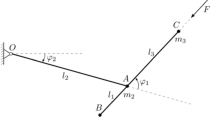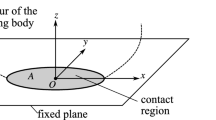Abstract
We consider dynamical systems from mechanics for which, due to some non-smooth friction effects, Oseledets' Multiplicative Ergodic Theorem cannot be applied canonically to define Lyapunov exponents. For general non-smooth systems which fit into a natural formal framework, we construct a suitable cocycle which lives on a “good” invariant set of full Lebesgue measure. Afterwards, this construction is applied to investigate a pendulum with dry friction, described through the equation \(\ddot x + x + \operatorname{sgn} \dot x = \gamma \sin (\eta t)\). The Lyapunov exponents obtained by our construction show a good agreement with the dynamical behaviour of the system, and since we will prove that these Lyapunov exponents are always non-positive, we conclude that the system does not show “chaotic behaviour.”
Similar content being viewed by others
REFERENCES
Alfsen, E. M. (1971). Compact Convex Sets and Boundary Integrals, Springer, Berlin/ Heidelberg/New York.
Andronov, A. A., and Chaikin, C. E. (1949). Theory of Oscillations, Princeton University Press, Princeton.
Bainov, D. D., Zabreiko, P. P., and Kostadinov, S. T. (1988). Stability of the general exponent of nonlinear impulsive differential equations in a Banach space. Int. J. Theoretical Phys. 27, 373-380.
Berger, B. S., and Rokni, M. (1990). Lyapunov exponents for discontinuous differential equations. Quarterly Appl. Math. 48, 549-553.
Budd, C., and Dux, F. (1994). Intermittency in impact oscillators close to resonance. Nonlinearity 7, 1191-1224.
Budd, C., and Lamba, H. (1994). Scaling of Lyapunov exponents at nonsmooth bifurcations. Phys. Rev. E 50, 84-90.
Deimling, K. (1985). Nonlinear Functional Analysis, Springer, Berlin/Heidelberg/New York/Tokyo.
Deimling, K. (1992). Multivalued Differential Equations, de Gruyter, Berlin/New York.
Deimling, K. (1994). Resonance and Coulomb friction. Diff. Int. Eq. 7, 759-765.
Deimling, K., and Szilágyi, P. (1994). Periodic solutions of dry friction problems. Z. Angew. Math. Phys. 45, 53-60.
Eckmann, J. P., and Ruelle, D. (1985). Ergodic theory of chaos and strange attractors. Reviews of Modern Phys. 57, 617-656.
Fečkan, M. (1996). Bifurcations from homoclinic to periodic solutions in ordinary differential equations with multivalued perturbations. J. Diff. Eq. 130, 415-450.
Filippov, A. F. (1988). Differential Equations with Discontinuous Right-Hand Sides, Kluwer Academic, Dordrecht/Boston/London.
Galvanetto, U., and Bishop, S. R. (1995). Characterization of the dynamics of a four-dimensional stick-slip system by a scalar variable. Chaos, Solitons & Fractals 5, 2171-2179.
Georgii, H. O. (1988). Gibbs Measures and Phase Transitions, de Gruyter, Berlin/New York.
Katok, A., and Strelcyn, V. (1986). Invariant Manifolds, Entropy and Billiards; Smooth Maps with Singularities, Lecture Notes in Mathematics, Vol. 1222, Springer, Berlin/Heidelberg/New York/Tokyo.
Kauderer, H. (1958). Nichtlineare Mechanik, Springer, Berlin/Heidelberg.
Kunze, M. (1998). Unbounded solutions in non-smooth dynamical systems at resonance. Z. Angew. Math. Mech. 78, Supplement 3, S985-S986.
Kunze, M., and Küpper, T. (1997). Qualitative bifurcation analysis of a non-smooth friction-oscillator model. Z. Ang. Math. Phys. 48, 1-15.
Kunze, M., and Michaeli, B. (1995). On the rigorous applicability of Oseledets' ergodic theorem to obtain Lyapunov exponents non-smooth dynamical systems, to appear in Proc. 2nd Marrakesh International Conference on Differential Equations, June 1995, Ed. O. Arino.
Lamba, H. (1993). Impacting Oscillators and Non-Smooth Dynamical Systems, Ph.D. thesis, University of Bristol.
Ledrappier, F. (1984). Quelques proprietés des exposants characteristiques. In Hennequin P. L. (ed.), École d'Été de Probabilités de Saint-Flour XII-1982, Lecture Notes in Mathematics, Vol. 1097, Springer, Berlin/Heidelberg/New York/Tokyo, pp. 305-396.
Michaeli, B. (1999). Lyapunov-Exponenten für nichtglatte dynamische Systeme, Ph.D. thesis, Universität Köln.
Müller, P. C. (1995). Calculation of Lyapunov exponents for dynamic systems with discontinuities. Chaos, Solitons & Fractals 5, 1671-1681.
Oestreich, M., Hinrichs, N., and Popp, K. (1996). Bifurcation and stability analysis for a non-smooth friction oscillator. Archive of Applied Mechanics 66, 301-314.
Oseledets, V. I. (1968). A multiplicative ergodic theorem. Lyapunov characteristic numbers for dynamical systems. Trans. Mosc. Math. Soc. 19, 197-231.
Pollicott, M. (1993). Lectures on Ergodic Theory and Pesin Theory on Compact Manifolds, London Math. Soc. LNS, Vol. 180, Cambridge University Press, Cambridge.
Popp, K., Hinrichs, N., and Oestreich, M. (1995). Dynamical behaviour of a friction oscillator with simultaneous self and external excitation, Sādhanā 20, 627-654.
Popp, K., and Stelter, P. (1990). Stick-slip vibrations and chaos, Phil. Trans. Roy. Soc. Lond. A 332, 89-105.
Reissig, R. (1953). Ñber die Differentialgleichung \({{d^2 x} \mathord{\left/ {\vphantom {{d^2 x} {d\tau + 2D \cdot \left( {{{dx} \mathord{\left/ {\vphantom {{dx} {d\tau }}} \right. \kern-\nulldelimiterspace} {d\tau }}} \right) + \mu \cdot \operatorname{sgn} \left( {{{dx} \mathord{\left/ {\vphantom {{dx} {d\tau }}} \right. \kern-\nulldelimiterspace} {d\tau }}} \right) + x = \Phi }}} \right. \kern-\nulldelimiterspace} {d\tau + 2D \cdot \left( {{{dx} \mathord{\left/ {\vphantom {{dx} {d\tau }}} \right. \kern-\nulldelimiterspace} {d\tau }}} \right) + \mu \cdot \operatorname{sgn} \left( {{{dx} \mathord{\left/ {\vphantom {{dx} {d\tau }}} \right. \kern-\nulldelimiterspace} {d\tau }}} \right) + x = \Phi }}\left( {\eta \tau } \right),wo\Phi \left( {\eta \tau + 2\pi } \right) \equiv {{d^2 x} \mathord{\left/ {\vphantom {{d^2 x} {d\tau + 2D \cdot \left( {{{dx} \mathord{\left/ {\vphantom {{dx} {d\tau }}} \right. \kern-\nulldelimiterspace} {d\tau }}} \right) + \mu \cdot \operatorname{sgn} \left( {{{dx} \mathord{\left/ {\vphantom {{dx} {d\tau }}} \right. \kern-\nulldelimiterspace} {d\tau }}} \right) + x = \Phi }}} \right. \kern-\nulldelimiterspace} {d\tau + 2D \cdot \left( {{{dx} \mathord{\left/ {\vphantom {{dx} {d\tau }}} \right. \kern-\nulldelimiterspace} {d\tau }}} \right) + \mu \cdot \operatorname{sgn} \left( {{{dx} \mathord{\left/ {\vphantom {{dx} {d\tau }}} \right. \kern-\nulldelimiterspace} {d\tau }}} \right) + x = \Phi }}\left( {\eta \tau } \right)\) ist. Das Verhalten der Lösungen für τ \(\tau \to \infty \). Abhandlungen der Deutschen Akademie der Wissenschaften zu Berlin, Klasse für Mathematik und Naturwissenschaften 1.
Reissig, R. (1954). Erzwungene Schwingungen mit zäher und trockner Reibung. Math. Nachr. 11, 345-384.
Reissig, R. (1954). Erzwungene Schwingungen mit zäher Reibung und starker Gleitreibung II. Math. Nachr. 12, 119-128.
Reissig, R. (1954). Erzwungene Schwingungen mit zäher und trockner Reibung: Ergänzung. Math. Nachr. 12, 249-252.
Reissig, R. (1954). Erzwungene Schwingungen mit zäher und trockner Reibung: Abschätzung der Amplituden. Math. Nachr. 12, 283-300.
Ruelle, D. (1979). Ergodic theory of differentiable dynamical systems. Publ. Math. IHES 50, 275-306.
Schneider, E., Popp, K., and Irretier, H. (1988). Noise generation in railway wheels due to rail-wheel contact forces, J. Sound Vib. 120, 227-244.
Schwartz, J. T. (1969). Nonlinear Functional Analysis, Gordon and Breach, New York.
Wiederhöft, A. (1994). Der periodisch erregte Einmassenreibschwinger, Diplom Thesis, Universität Köln.
Author information
Authors and Affiliations
Rights and permissions
About this article
Cite this article
Kunze, M. On Lyapunov Exponents for Non-Smooth Dynamical Systems with an Application to a Pendulum with Dry Friction. Journal of Dynamics and Differential Equations 12, 31–116 (2000). https://doi.org/10.1023/A:1009046702601
Issue Date:
DOI: https://doi.org/10.1023/A:1009046702601




